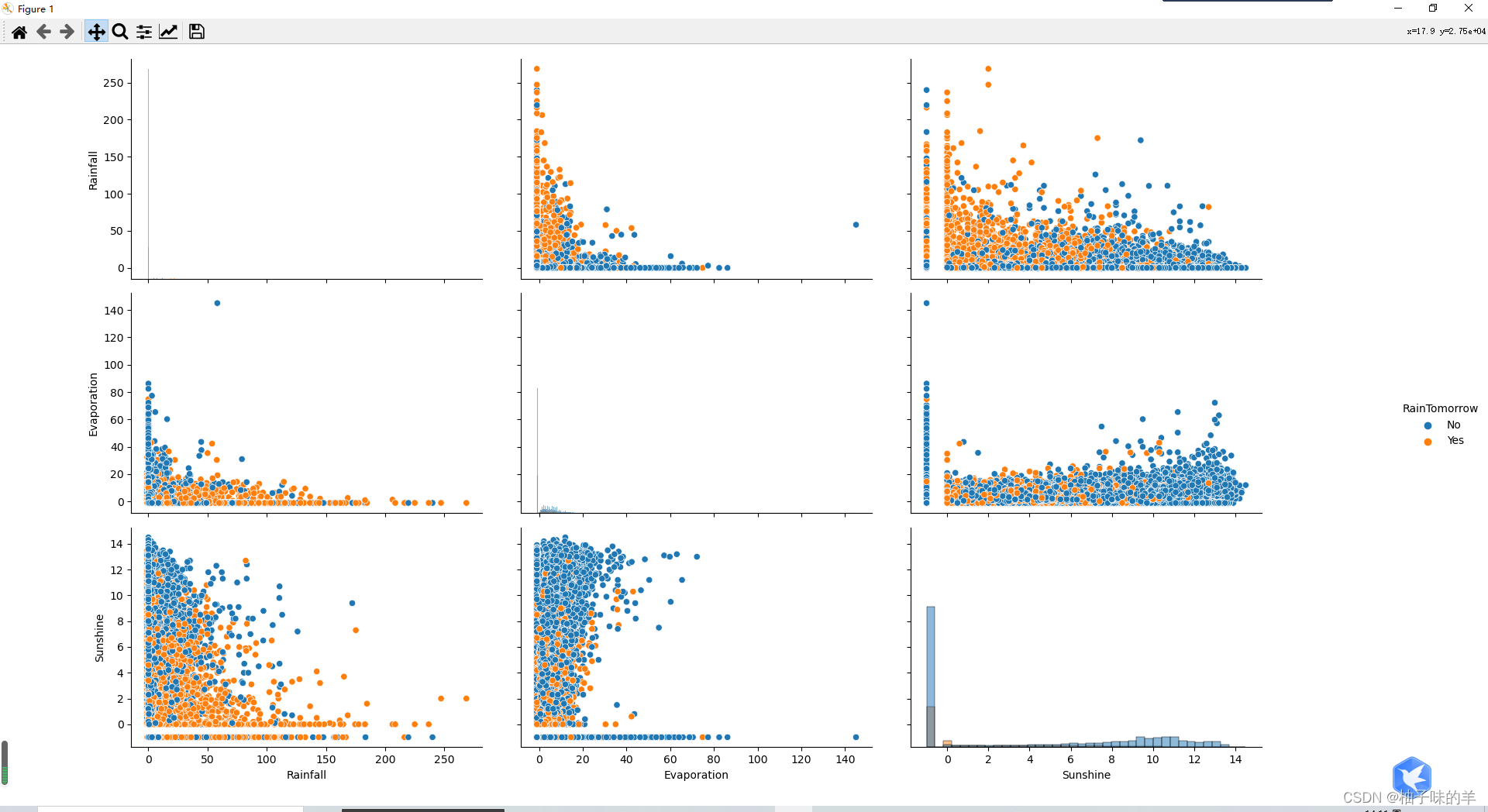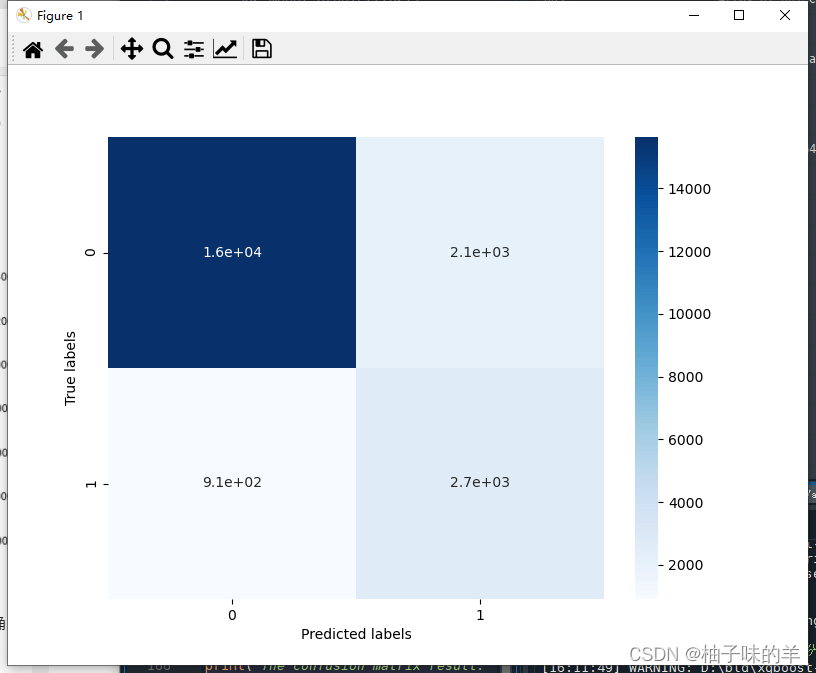Python机器学习应用之基于天气数据集的XGBoost分类篇解读
XGBoost是一个优化的分布式梯度增强库,旨在实现高效,灵活和便携。它在 Gradient Boosting 框架下实现机器学习算法。XGBoost提供并行树提升(也称为GBDT,GBM),可以快速准确地解决许多数据科学问题
目录
一、XGBoost
1 XGBoost的优点
2 XGBoost的缺点
二、实现过程
1 数据集
2 实现
三、Keys
XGBoost的重要参数
一、XGBoost
XGBoost并不是一种模型,而是一个可供用户轻松解决分类、回归或排序问题的软件包。
1 XGBoost的优点
简单易用。相对其他机器学习库,用户可以轻松使用XGBoost并获得相当不错的效果。
高效可扩展。在处理大规模数据集时速度快效果好,对内存等硬件资源要求不高。
鲁棒性强。相对于深度学习模型不需要精细调参便能取得接近的效果。
XGBoost内部实现提升树模型,可以自动处理缺失值。
2 XGBoost的缺点
相对于深度学习模型无法对时空位置建模,不能很好地捕获图像、语音、文本等高维数据。
在拥有海量训练数据,并能找到合适的深度学习模型时,深度学习的精度可以遥遥领先XGBoost。
二、实现过程
1 数据集
天气数据集 提取码:1234
2 实现
1 2 3 4 5 6 7 8 9 | #%%导入基本库import numpy as np import pandas as pd## 绘图函数库import matplotlib.pyplot as pltimport seaborn as sns#读取数据data=pd.read_csv('D:\Python\ML\data\XGBtrain.csv') |
通过variable explorer查看样本数据

也可以使用head()或tail()函数,查看样本前几行和后几行。不难看出,数据集中含有NAN,代表数据中存在缺失值,可能是在数据采集或者处理过程中产生的一种错误,此处采用-1将缺失值进行填充,还有其他的填充方法:
中位数填补
平均数填补
注:在数据的前期处理中,一定要注意对缺失值的处理。前期数据处理的结果将会严重影响后面是否可能得到合理的结果
1 2 3 4 | data=data.fillna(-1)#利用value_counts()函数查看训练集标签的数量(Raintomorrow=no)print(pd.Series(data['RainTomorrow']).value_counts())data_des=data.describe() |
填充后:

1 2 3 4 5 6 | #%%#可视化数据(特征值包括数字特征和非数字特征)numerical_features = [x for x in data.columns if data[x].dtype == np.float]category_features = [x for x in data.columns if data[x].dtype != np.float and x != 'RainTomorrow']#%% 选取三个特征与标签组合的散点可视化sns.pairplot(data=data[['Rainfall','Evaporation','Sunshine'] + ['RainTomorrow']], diag_kind='hist', hue= 'RainTomorrow')plt.show() |

1 2 3 4 5 6 7 8 9 | #%%每个特征的箱图i=0for col in data[numerical_features].columns: if col != 'RainTomorrow': plt.subplot(2,8,i+1) sns.boxplot(x='RainTomorrow', y=col, saturation=0.5, palette='pastel', data=data) plt.title(col) i=i+1plt.show() |

1 2 3 4 5 6 7 8 9 10 11 12 13 14 15 16 | #%%非数字特征tlog = {}for i in category_features: tlog[i] = data[data['RainTomorrow'] == 'Yes'][i].value_counts()flog = {}for i in category_features: flog[i] = data[data['RainTomorrow'] == 'No'][i].value_counts()#%%不同地区下雨情况plt.figure(figsize=(20,10))plt.subplot(1,2,1)plt.title('RainTomorrow')sns.barplot(x = pd.DataFrame(tlog['Location']).sort_index()['Location'], y = pd.DataFrame(tlog['Location']).sort_index().index, color = "red")plt.subplot(1,2,2)plt.title('Not RainTomorrow')sns.barplot(x = pd.DataFrame(flog['Location']).sort_index()['Location'], y = pd.DataFrame(flog['Location']).sort_index().index, color = "blue")plt.show() |

1 2 3 4 5 6 7 8 9 | #%%plt.figure(figsize=(20,5))plt.subplot(1,2,1)plt.title('RainTomorrow')sns.barplot(x = pd.DataFrame(tlog['RainToday'][:2]).sort_index()['RainToday'], y = pd.DataFrame(tlog['RainToday'][:2]).sort_index().index, color = "red")plt.subplot(1,2,2)plt.title('Not RainTomorrow')sns.barplot(x = pd.DataFrame(flog['RainToday'][:2]).sort_index()['RainToday'], y = pd.DataFrame(flog['RainToday'][:2]).sort_index().index, color = "blue")plt.show() |

XGBoost无法处理字符串类型的数据,需要将字符串数据转化成数值
1 2 3 4 5 6 7 8 9 10 11 12 13 14 15 16 17 18 19 20 21 22 23 24 25 26 27 28 29 30 31 32 33 34 35 36 37 38 39 40 41 42 43 44 45 46 47 48 49 50 | #%%对离散变量进行编码## 把所有的相同类别的特征编码为同一个值def get_mapfunction(x): mapp = dict(zip(x.unique().tolist(), range(len(x.unique().tolist())))) def mapfunction(y): if y in mapp: return mapp[y] else: return -1 return mapfunction#将非数字特征离散化for i in category_features: data[i] = data[i].apply(get_mapfunction(data[i]))#%%利用XGBoost进行训练与预测## 为了正确评估模型性能,将数据划分为训练集和测试集,并在训练集上训练模型,在测试集上验证模型性能。from sklearn.model_selection import train_test_split## 选择其类别为0和1的样本 (不包括类别为2的样本)data_target_part = data['RainTomorrow']data_features_part = data[[x for x in data.columns if x != 'RainTomorrow']]## 测试集大小为20%, 80%/20%分x_train, x_test, y_train, y_test = train_test_split(data_features_part, data_target_part, test_size = 0.2, random_state = 2020)#%%导入XGBoost模型from xgboost.sklearn import XGBClassifier## 定义 XGBoost模型 clf = XGBClassifier()# 在训练集上训练XGBoost模型clf.fit(x_train, y_train)#%% 在训练集和测试集上分布利用训练好的模型进行预测train_predict = clf.predict(x_train)test_predict = clf.predict(x_test)from sklearn import metrics## 利用accuracy(准确度)【预测正确的样本数目占总预测样本数目的比例】评估模型效果print('The accuracy of the XGBoost is:',metrics.accuracy_score(y_train,train_predict))print('The accuracy of the XGBoost is:',metrics.accuracy_score(y_test,test_predict))## 查看混淆矩阵 (预测值和真实值的各类情况统计矩阵)confusion_matrix_result = metrics.confusion_matrix(test_predict,y_test)print('The confusion matrix result:\n',confusion_matrix_result)# 利用热力图对于结果进行可视化plt.figure(figsize=(8, 6))sns.heatmap(confusion_matrix_result, annot=True, cmap='Blues')plt.xlabel('Predicted labels')plt.ylabel('True labels')plt.show() |

1 2 3 | #%%利用XGBoost进行特征选择:#XGboost中可以用属性feature_importances_去查看特征的重要度。sns.barplot(y=data_features_part.columns,x=clf.feature_importances_) |

初次之外,我们还可以使用XGBoost中的下列重要属性来评估特征的重要性:
weight:是以特征用到的次数来评价
gain:当利用特征做划分的时候的评价基尼指数
cover:利用一个覆盖样本的指标二阶导数(具体原理不清楚有待探究)平均值来划分。
total_gain:总基尼指数
total_cover:总覆盖
1 2 3 4 5 6 7 8 9 10 11 12 13 14 15 16 17 18 19 20 21 22 23 | #利用XGBoost的其他重要参数评估特征的重要性from sklearn.metrics import accuracy_scorefrom xgboost import plot_importancedef estimate(model,data): #sns.barplot(data.columns,model.feature_importances_) ax1=plot_importance(model,importance_type="gain") ax1.set_title('gain') ax2=plot_importance(model, importance_type="weight") ax2.set_title('weight') ax3 = plot_importance(model, importance_type="cover") ax3.set_title('cover') plt.show()def classes(data,label,test): model=XGBClassifier() model.fit(data,label) ans=model.predict(test) estimate(model, data) return ans ans=classes(x_train,y_train,x_test)pre=accuracy_score(y_test, ans)print('acc=',accuracy_score(y_test,ans)) |




XGBoost中包括但不限于下列对模型影响较大的参数:
learning_rate: 有时也叫作eta,系统默认值为0.3。每一步迭代的步长,很重要。太大了运行准确率不高,太小了运行速度慢。
subsample:系统默认为1。这个参数控制对于每棵树,随机采样的比例。减小这个参数的值,算法会更加保守,避免过拟合, 取值范围零到一。
colsample_bytree:系统默认值为1。我们一般设置成0.8左右。用来控制每棵随机采样的列数的占比(每一列是一个特征)。max_depth: 系统默认值为6,我们常用3-10之间的数字。这个值为树的最大深度。这个值是用来控制过拟合的。
max_depth越大,模型学习的更加具体。
调节模型参数的方法有贪心算法、网格调参、贝叶斯调参等。这里我们采用网格调参,它的基本思想是穷举搜索:在所有候选的参数选择中,通过循环遍历,尝试每一种可能性,表现最好的参数就是最终的结果
1 2 3 4 5 6 7 8 9 10 11 12 13 14 15 16 17 18 19 20 21 | #%%通过调参获得更好的效果## 从sklearn库中导入网格调参函数from sklearn.model_selection import GridSearchCV## 定义参数取值范围learning_rate = [0.1, 0.3, 0.6]subsample = [0.8, 0.9]colsample_bytree = [0.6, 0.8]max_depth = [3,5,8]parameters = { 'learning_rate': learning_rate, 'subsample': subsample, 'colsample_bytree':colsample_bytree, 'max_depth': max_depth}model = XGBClassifier(n_estimators = 50)## 进行网格搜索clf = GridSearchCV(model, parameters, cv=3, scoring='accuracy',verbose=1,n_jobs=-1)clf = clf.fit(x_train, y_train)#%%网格搜索后的参数print(clf.best_params_) |

1 2 3 4 5 6 7 8 9 10 11 12 13 14 15 16 17 18 19 20 21 22 23 | #%% 在训练集和测试集上分别利用最好的模型参数进行预测## 定义带参数的 XGBoost模型 clf = XGBClassifier(colsample_bytree = 0.6, learning_rate = 0.3, max_depth= 8, subsample = 0.9)# 在训练集上训练XGBoost模型clf.fit(x_train, y_train)train_predict = clf.predict(x_train)test_predict = clf.predict(x_test)## 利用accuracy(准确度)【预测正确的样本数目占总预测样本数目的比例】评估模型效果print('The accuracy of the Logistic Regression is:',metrics.accuracy_score(y_train,train_predict))print('The accuracy of the Logistic Regression is:',metrics.accuracy_score(y_test,test_predict))## 查看混淆矩阵 (预测值和真实值的各类情况统计矩阵)confusion_matrix_result = metrics.confusion_matrix(test_predict,y_test)print('The confusion matrix result:\n',confusion_matrix_result)# 利用热力图对于结果进行可视化plt.figure(figsize=(8, 6))sns.heatmap(confusion_matrix_result, annot=True, cmap='Blues')plt.xlabel('Predicted labels')plt.ylabel('True labels')plt.show() |


三、Keys
XGBoost的重要参数
eta【默认0.3】:通过为每一颗树增加权重,提高模型的鲁棒性。典型值为0.01-0.2。
min_child_weight【默认1】:决定最小叶子节点样本权重和。这个参数可以避免过拟合。当它的值较大时,可以避免模型学习到局部的特殊样本。但是如果这个值过高,则会导致模型拟合不充分。
max_depth【默认6】:这个值也是用来避免过拟合的,max_depth越大,模型会学到更具体更局部的样本。典型值:3-10
max_leaf_nodes:树上最大的节点或叶子的数量。可以替代max_depth的作用。这个参数的定义会导致忽略max_depth参数。
gamma【默认0】:在节点分裂时,只有分裂后损失函数的值下降了,才会分裂这个节点。Gamma指定了节点分裂所需的最小损失函数下降值。这个参数的值越大,算法越保守。这个参数的值和损失函数息息相关。
max_delta_step【默认0】:这个参数限制每棵树权重改变的最大步长。如果这个参数的值为0,那就意味着没有约束。如果它被赋予了某个正值,那么它会让这个算法更加保守。但是当各类别的样本十分不平衡时,它对分类问题是很有帮助的。
subsample【默认1】:这个参数控制对于每棵树,随机采样的比例。减小这个参数的值,算法会更加保守,避免过拟合。但是,如果这个值设置得过小,它可能会导致欠拟合。典型值:0.5-1
colsample_bytree【默认1】:用来控制每棵随机采样的列数的占比(每一列是一个特征)。典型值:0.5-1
colsample_bylevel【默认1】:用来控制树的每一级的每一次分裂,对列数的采样的占比。subsample参数和colsample_bytree参数可以起到相同的作用,一般用不到。
lambda【默认1】:权重的L2正则化项。(和Ridge regression类似)。这个参数是用来控制XGBoost的正则化部分的。虽然大部分数据科学家很少用到这个参数,但是这个参数在减少过拟合上还是可以挖掘出更多用处的。
alpha【默认1】:权重的L1正则化项。(和Lasso regression类似)。可以应用在很高维度的情况下,使得算法的速度更快。
scale_pos_weight【默认1】:在各类别样本十分不平衡时,把这个参数设定为一个正值,可以使算法更快收敛。
886~~
到此这篇关于Python机器学习应用之基于天气数据集的XGBoost分类篇解读的文章就介绍到这了
原文链接:https://blog.csdn.net/qq_43368987/article/details/122403564?spm=1001.2014.3001.5501

